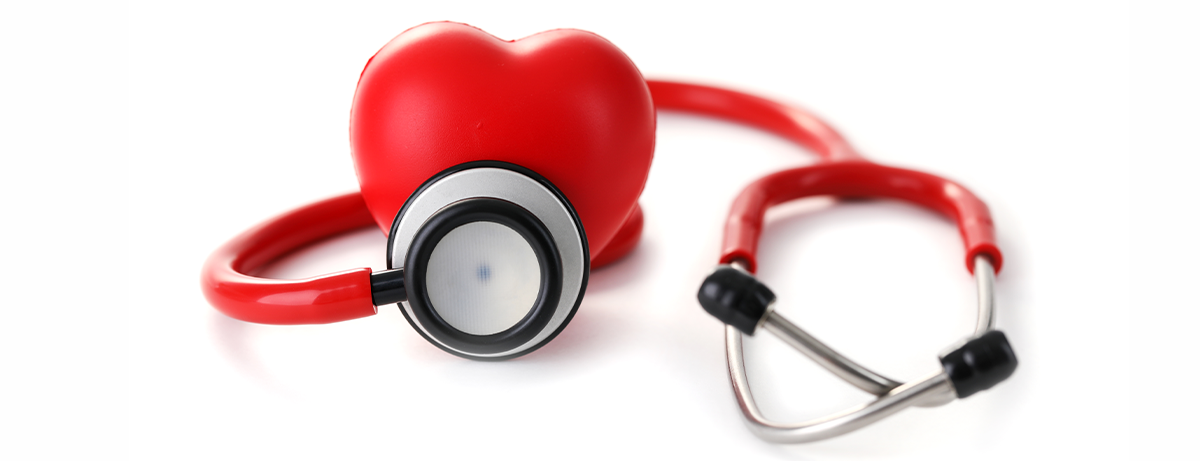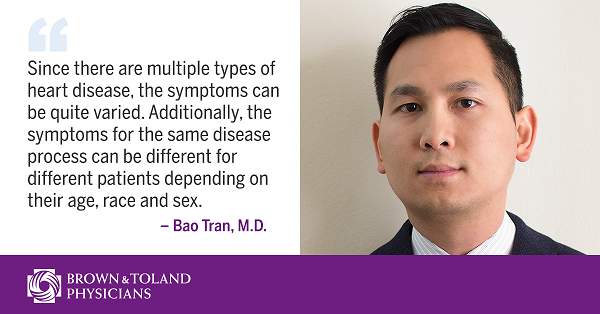Dr. Bao Tran: Answering Some Common Questions About Heart Health

Did you know someone dies of cardiovascular disease (CVD) every 40 seconds? With 17.3 million deaths each year, CVD, including heart disease and stroke, is the leading global cause of death. And that number is expected to rise to 23.6 million by 2030.

February was established as American Heart Month in 1964 to serve as a reminder to focus on our hearts and encourage heart health among our families, friends and communities. To that end, we sat down with Brown & Toland cardiovascular specialist Bao Tran, MD, to ask some questions about the different kinds of heart disease and what you can do to lead a heart healthy life.
What are some common misconceptions about heart health?
People sometimes say “I have heart disease” or “my parents have heart disease” without knowing exactly what that means. The heart is a very complex organ. I like to break it down in terms of the most common problems that can occur:
- Coronary artery disease. This leads to the classic heart attack that is often portrayed in the media. The chronic form of coronary artery disease can lead to angina and heart failure.
- Arrhythmia. Problems can occur when the electrical impulses that coordinate the heart don’t work properly. This either causes the heart to beat too fast, too slow, or irregularly.
- Valvular heart disease. Heart valves divide the heart chambers and maintain one-way blood flow through the heart. These valves can degenerate over time due to “wear-and-tear” or can degenerate early due to congenital abnormalities.
- Heart pump disease. The heart ultimately is a pump that circulates blood around the body. Many things can cause the pump to weaken and cause the syndrome of congestive heart failure.
What are some other things you want people to know about heart health?
My specialty is cardiovascular medicine, and I like to remind people that the vascular aspect is just as important as the cardiac aspect.
Patients can develop disease in arteries outside of the heart. This can lead to stroke (from carotid artery disease), pain with eating (from mesenteric arteries disease), severe high blood pressure and renal failure (from renal artery disease), and leg pain and leg ulcers (from lower extremity artery disease). Disease in the venous system can be just as debilitating. Venous disease can lead to swelling or edema and venous ulcers in the legs.
Disease in both arteries and venous systems are easy to treat – the most difficult part is often making the correct diagnosis.
What are signs that something may be wrong with my heart?
Since there are multiple types of heart disease, the symptoms can be quite varied. Additionally, the symptoms for the same disease process can be different for different patients depending on their age, race and sex. The most common symptoms that I try to elicit from patients are shortness of breath or a rapid decrease in exercise tolerance, swelling in the legs, chest tightness or pressure with exertion, frequent dizziness or lightheadedness, and fainting. Especially in older patients or women, coronary artery disease also can present atypically with symptoms of nausea, indigestion, arm pain, jaw pain and back pain.
From a vascular disease standpoint, any type of ulcer or wound in the legs or feet that is slow to heal should raise concern about arterial or venous disease. Cramping or pain in the legs with walking or at the end of the day can also indicate circulatory problems.
What are some things anyone can do to protect their heart?
There are many things that have been proven to reduce your chances of getting heart disease.
- Blood pressure control. Your blood pressure should be under 140/90 and for some patients should be under 130/80.
- Cholesterol control. Your LDL (bad cholesterol) and triglyceride are the most important numbers to keep in mind.
- Healthy diet. There are many different diets out there that have varying degrees of evidence. I generally advocate for a diet that is composed of whole grains, more plants than meat, less carbohydrates, less oil, less processed food and less salt.
- Don’t smoke. Smoking is by far one of the worst things that you can do for your heart.
- Regular exercise. This can be aerobics or weight training. Just get moving!
How has heart care changed in the last few years?
Over the last decade, there have been striking changes in medical therapy and procedures.
From a medical therapy standpoint, there are new drugs developed that have been shown to dramatically reduce cholesterol (PCSK9 inhibitors), reduce mortality for patients with heart failure (ARNI and SGLT2-i), and reduce ischemic events in patients (DOACs).
From a procedural standpoint, the trend has been the broadening of minimally invasive techniques. Procedures that 10 years ago required open heart surgery can now be performed through a small puncture in the vein or artery (complex percutaneous coronary intervention (PCI) in place of coronary bypass surgery, TAVR in place of aortic valve replacement, MitraClip in place of mitral valve repair, and so on.
Bao Tran, MD, is an interventional cardiologist who specializes in complex coronary interventions, peripheral vascular interventions (including peripheral artery disease, deep vein thrombosis, pulmonary embolism), endovenous ablation procedures, and structural heart interventions. Dr. Tran graduated from the Perelman School of Medicine at the University of Pennsylvania and completed internal medicine training at the University of California, San Francisco (UCSF). He went on to cardiology training at the University of California, Los Angeles (UCLA) and then interventional cardiology training at Kaiser Permanente, Los Angeles. His offices are in San Francisco and Daly City, and he performs procedures at Saint Mary’s Medical Center, CPMC Van Ness, Seton Medical Center and Mills-Peninsula Medical Center.
MEDICAL DISCLAIMER: The content of this website or blog is not intended to be a substitute for professional medical advice, diagnosis or treatment. Always seek the advice of your physician or other qualified health provider with any questions you may have regarding a medical condition. Never disregard professional medical advice or delay in seeking it because of something you have read on this website or blog.
If you think you may have a medical emergency, call 911 immediately, call your doctor, or go to the emergency room/urgent care facility.
